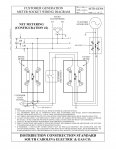peterlarsen.suntec
Member
- Location
- NC/SC
We have a new service requirements manual from our utility here in SC. It's great news, now we an all get on the same page, installers, utility, and inspectors!
We have options to land the GEC either in the meter or at the "first point of accessible disconnect".

In reference to net metered solar interconnections, the manual offers 3 methods to connect. There is the typical method of back feeding into a MDP, and two options for supply side connections. One option includes a trough, the other is a supply side meter connection. Please see below.

We are using option (A). The question is, when using the UL listed accessory double lug kit on the load side of the POC, where would be the best place to land the GEC?
Which one is easier to change if required by an inspector with a differing opinion of the best selection?
We have options...
According to Duke as shown in figure 14A we can bond at the "in service disconnecting means". This means we can land our #6 bare GEC in the PV meter or the PV disconnect.
Approach 1:
We can land the neutral in the disco at an isolated neutral terminal, we can land an auxiliary GEC on a ground bar. Then we can treat the PV disconnect as a service disconnect or a feeder disconnect by installing the bonding screw or not.
Approach 2:
We can land an auxiliary GEC in the PV meter, then run separate neutral and EGC to the disco landing the neutral and EGC as described above. Again, installing the bonding jumper screw will determine weather it is considered a service disconnect or feeder disconnect.
Since the PV meter is technically "not accessible" because you must cut the tab to remove it, it may not be viewed as the "disconnecting means" by an inspector.
I would be inclined to pick option 1. What do you guys think?
Sent from my iPad using Tapatalk
We have options to land the GEC either in the meter or at the "first point of accessible disconnect".

In reference to net metered solar interconnections, the manual offers 3 methods to connect. There is the typical method of back feeding into a MDP, and two options for supply side connections. One option includes a trough, the other is a supply side meter connection. Please see below.

We are using option (A). The question is, when using the UL listed accessory double lug kit on the load side of the POC, where would be the best place to land the GEC?
Which one is easier to change if required by an inspector with a differing opinion of the best selection?
We have options...
According to Duke as shown in figure 14A we can bond at the "in service disconnecting means". This means we can land our #6 bare GEC in the PV meter or the PV disconnect.
Approach 1:
We can land the neutral in the disco at an isolated neutral terminal, we can land an auxiliary GEC on a ground bar. Then we can treat the PV disconnect as a service disconnect or a feeder disconnect by installing the bonding screw or not.
Approach 2:
We can land an auxiliary GEC in the PV meter, then run separate neutral and EGC to the disco landing the neutral and EGC as described above. Again, installing the bonding jumper screw will determine weather it is considered a service disconnect or feeder disconnect.
Since the PV meter is technically "not accessible" because you must cut the tab to remove it, it may not be viewed as the "disconnecting means" by an inspector.
I would be inclined to pick option 1. What do you guys think?
Sent from my iPad using Tapatalk


